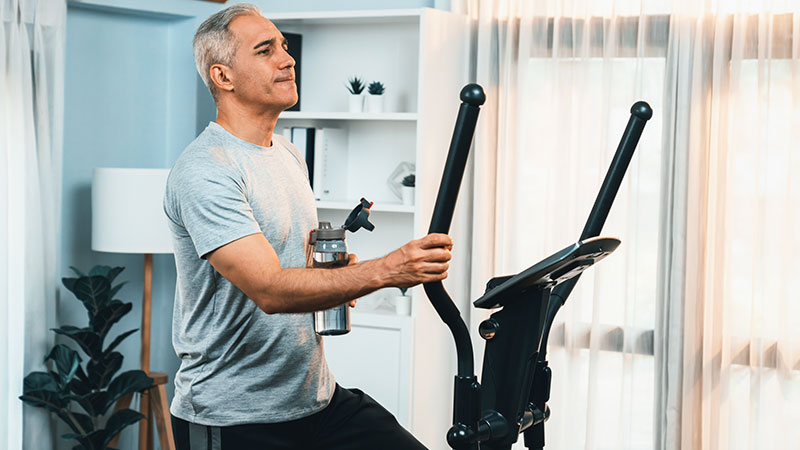Aging gracefully isn’t just about maintaining physical health, but also about keeping our cognitive functions sharp.
In this digital age, cyber fitness has emerged as a potent tool to aid seniors in achieving this goal. With the right tools and guidance, it’s possible to keep our minds agile and robust, no matter our age.
This article will delve into the world of cyber fitness for seniors, exploring its potential benefits and how it can be incorporated into daily routines.
We’ll be discussing the specifications of some of the tools used in cyber fitness, such as a device weighing 245 lbs with dimensions of 72x28x53 in, requiring power and data, and featuring a 26.5 in touchscreen with full 1080p resolution.
So, if you’re interested in learning more about how technology can help in enhancing cognitive functioning in seniors, keep reading. This could be the start of a fitter, healthier, and more active life for you or your loved ones.

Understanding Cyber Fitness for Seniors
In this age of technology, you, as a senior, must stay physically active while maintaining your mental agility.
This concept, called Cyber Fitness, plays a crucial role in boosting your cognitive health and well-being and keeping you ahead in the digital age. Let’s dive deeper to understand the relevance of Cyber Fitness for seniors and its lasting impacts.
The Importance of Cyber Fitness in the Digital Age
Cyber-fitness is crucial in today’s digital landscape for several reasons:
- Improved cybersecurity awareness: Cyber-fitness education makes individuals aware of potential cyber threats and vulnerabilities in the digital world, which is the first step in protecting against cyber-attacks.
- Career opportunities: Studying cybersecurity can open up career opportunities in a high-demand field, with diverse roles like Information Security Manager, Cyber Security Engineer, and Cyber Security Analyst commanding high salaries.
- Reduced operational disruption: Educational institutions and organizations need to function without operational disruptions caused by cyber-attacks. Cyber-fitness helps maintain productivity and focus on innovations.
- Social responsibility: Promoting digital security helps create a safer digital environment for individuals and society. Educated and aware individuals will foster cybersecurity in their homes and workplaces
How Seniors Are At Risk Online?
Seniors, like yourself, can become easy targets for cybercriminals due to several reasons. First, digital literacy may not be a strong suit for those not born in the tech-savvy generation.
Hence, this group tends to overlook the signs of potential threats, such as phishing emails and fraudulent websites.
Secondly, seniors are usually more trusting, which cybercriminals exploit. It’s crucial to be aware that not all information or offers online are genuine, and you should always verify the sources.
Lastly, your generation might find it challenging to keep up with the rapidly changing online environment. Too often, the threat isn’t apparent until it’s too late.
This harsh reality underlines the importance of proactively learning and staying up-to-date with Cyber Fitness practices.
Being Cyber Fit means strengthened defenses against online threats, added layers of protection for personal data, and a safer and more enjoyable online experience.
It’s a journey, where every step enhances your understanding, skillset, and confidence in navigating the digital world. In the end, Cyber Fitness doesn’t just prepare you for the digital age; it empowers you to embrace it dynamically.
Elements of a Senior-Friendly Cyber Fitness Program

Creating a senior-friendly cyber fitness program underlines the criticality of several elements. These components, together, shape an effective program that caters to the unique needs of the elderly.
Key Components of Effective Training
Creating an effective training structure for the elderly requires consideration of topic complexity and learning curve.
Fundamental elements should include cyber safety principles, risk identification, understanding scams, and strong password creation.
Besides these components, the frequency of teaching, time for practice, and Q&A sessions are also crucial to reinforce concepts and make them relatable for the elderly.
Tailoring the Curriculum for Elderly Learners
Cyber fitness programs for seniors should not adopt a one-size-fits-all approach but rather tailor the curriculum to the learners’ abilities and comfort levels.
Tools like pictorial representations, large fonts, and concise sentences can aid customization. Provisions for traditional learning materials like printouts or booklets should also be included if preferred by the elderly learners.
The focus should be on ensuring understanding of topics at a pace suitable to them rather than rushing through the curriculum.
Relevance of Personalized and Guided Sessions
Guided sessions with a skilled instructor are vital for seniors’ learning, offering personalized instruction tailored to their pace and understanding.
These sessions allow immediate responses to questions and foster an environment that respects seniors’ concerns.
Instead of just covering a syllabus, this interactive system helps seniors become comfortable with technology in a safe online setting.
Encouraging Seniors to Embrace Cyber Wellness

As we sail forth in the digital age, cyber wellness among seniors takes on increasing importance. This journey begins with understanding and overcoming any innate fear of technology.
Overcoming Fear of Technology
Seniors often have apprehensions about technology, fearing mistakes and harm. However, patient training and user-friendly platforms can help; for instance, health company Bold offers a simple, science-backed exercise routines platform for the elderly.
The platform has been effective in reducing falls by 46% and increasing physical activity by 182%.
Through partnerships with Medicare plans and providers, the service is freely accessible to 10M older adults, demonstrating how technology can be used respectfully to serve humanity.
Maintaining Security and Privacy in Online Activities
Online security and privacy are key concerns for seniors who need to be aware of potential risks and protection methods.
This includes using strong passwords, regularly updating software, configuring security settings properly, and utilizing privacy-enhancing tools such as VPNs or encrypted messaging apps.
Seniors should also be vigilant against scams, phishing attempts, and misleading information online.
Incorporating these elements into a senior’s cyber wellness program can boost their confidence in online interactions and enhance their digital life quality, fostering safer digital communities for everyone.
Role of Technology in Assisting Senior Cyber Fitness

In today’s connected world, technology plays a crucial role in promoting cyber fitness among seniors. Various resources and platforms utilize technology to make online safety more accessible for seniors and help improve their cyber skills.
Making Online Safety Easily Accessible for Seniors
Technology is being used to improve online safety and physical health for seniors. Initiatives like Cybersecurity 101 from the National Cyber Security Alliance use tech to educate about safe online practices,
While Bold’s digital platform provides personalized exercise routines for seniors in an effort to reduce healthcare costs and increase longevity.
These platforms, which are accessible to millions of older adults through partnerships with Medicare plans and providers, utilize technology advancements to promote cyber fitness among seniors.
Leveraging Resources to Learn and Improve Cyber Skills
Several free courses are available to help seniors boost their cyber skills. These include CSO Online Security Training, CISSP Self-Paced Training, and The Open University’s Introduction to Cyber Security course.
These resources offer a wide range of topics from network security to virus attack management and provide certifications for independent learning.
This highlights the importance of technology in promoting cyber fitness among seniors, enabling them to protect themselves from online threats.
Aftercare and Support for Senior Cyber Fitness Training

After completing cyber fitness training, seniors gain a better understanding of online safety, fundamental cyber skills, and the confidence to navigate the digital world.
However, the journey doesn’t stop there. Continual aftercare and support are essential to maintain these new skills while keeping abreast of changes and advancements in technology growth.
What Happens After the Training Session?
After finishing formal training, seniors can effectively use their new cyber skills for communication, transactions and online engagement.
However, due to the ever-evolving nature of technology and cybersecurity, they must stay updated with current trends and threats. Measures like follow-up sessions, refresher courses, and online resources can aid in continuous learning.
Maintaining Ongoing Support for Cyber Safety
The rapidly changing nature of technology necessitates continuous support for cyber safety, especially for seniors.
Organizations offer consistent updates on safety protocols and emerging technological trends, while services like the CyberSeniors program provide personalized tech support and free workshops.
Digital platforms such as Bold and CyberCycle merge physical exercise with cyber fitness practices, helping seniors maintain both physical health and online agility.
The integration of technology into daily routines, ongoing learning, and proper resources are key to maintaining cyber fitness among senior citizens. In today’s digital era, staying cyber fit is as vital as keeping physically healthy.
Why Seniors Should Invest in Cyber Fitness?
Investing in cyber fitness is crucial for seniors in the 21st century, as it encompasses physical, mental, and digital well-being. Here’s why seniors should prioritize improving their cyber fitness:
Staying Technologically Adept
In today’s world, nearly every aspect of life relies on technology. Being technologically adept allows seniors to engage more effectively with personal devices and digital platforms. This improves their ability to stay connected, access information, and manage daily tasks.
Enhancing Physical and Mental Health
Cyber fitness programs, such as those offered by Bold, have been shown to improve physical health by reducing fall risk by 46% and increasing weekly physical activity by 182%. These advancements in bodily health can also contribute to better mental well-being and cognitive function.
Protecting Against Cyber Threats
Cyber fitness equips seniors with the knowledge and tools to protect themselves against online threats, such as phishing scams and identity theft. This helps ensure secure digital interactions and safeguards personal data and privacy.
Promoting Inclusivity
Inclusive cyber fitness platforms, like Bold’s services made available to 10 million older adults through partnerships with Medicare plans and providers, recognize the growing population of seniors and their need for digital literacy.
This aligns with the projected increase in the number of adults over 65, set to outnumber those under 18 by 2034.
Reducing Healthcare Costs
Improved cyber fitness can lead to a decrease in avoidable healthcare costs. A digitally sound elderly population can contribute to curbing skyrocketing healthcare spending, while also improving life expectancy.
Assessing the Effectiveness of Cyber Fitness Programs for Seniors

Cyber fitness programs like the CyberCycle offer seniors an immersive and digital platform to stay active, combining interactive gaming elements to motivate users to exercise more frequently and intensively.
These programs, such as the CyberCycle, present users with varying sceneries and competitive challenges, enhancing user engagement and contributing to overall physical health.
Cognitive Benefits
Research indicates that user engagement with the CyberCycle can lead to enhanced cognitive functioning in seniors. This improvement in cognitive capabilities may reduce the risk of cognitive decline and related health conditions associated with aging, ultimately improving the quality of life for seniors.
Physical Health Benefits
In addition to cognitive gains, the physical benefits of frequent and intense workouts should not be underestimated.
Regular physical activity through cyber fitness programs can strengthen the heart, reduce the risk of certain cancers, and enhance mental health by lowering the risk of depression, improving mood, and overall well-being.
Technical Specifications
When evaluating cyber fitness programs like the CyberCycle, it is essential to consider technical specifications.
The CyberCycle, weighing 245 lbs and measuring 72x28x53 in, requires power and features a 26.5 in touchscreen with full 1080p resolution.
Notably, it includes a lifetime software subscription, showcasing a long-term commitment to user needs. Understanding these specifications can help users and institutions make informed decisions about integrating such programs.
Comprehensive Health Solutions
Cyber fitness programs offer a sustainable approach to health and wellness for seniors. The CyberCycle, with its ability to entertain, engage, and improve cognitive and physical health, presents a promising solution for aging individuals in the digital era.
By providing a holistic approach to fitness training, these programs have the potential to revolutionize healthy aging practices.
Frequently Asked Questions
How effective are programs like CyberCycle for seniors?
Programs like CyberCycle offer seniors an immersive digital platform to improve their physical and cognitive health through interactive gaming. It’s an effective tool for maintaining overall well-being in the digital era.
Is age a barrier to learning cybersecurity?
Absolutely not! Age is not a barrier to learning cybersecurity. Anyone can switch to a cybersecurity career with the right motivation, dedication, and mindset regardless of age.
When did Cyber-Seniors begin?
Cyber-Seniors began in 2009 as a high-school project. It later inspired an award-winning documentary film that reached an international audience.
What to do if a senior is being scammed?
If a senior is being scammed, report it to IdentifyTheft.gov for identity theft, Elder Abuse Resource Roadmap for financial abuse, or ReportFraud.ftc.gov for different types of fraud.
Is Cyber-Seniors free for older adults?
Yes, Cyber-Seniors provides free technology support and training for older adults, ensuring their inclusivity in the digital era.
Who helps seniors learn digital technology?
Organizations like OATS lead the way in creating programs to assist seniors in using digital technology effectively for a more fulfilling, safer, and financially secured life.
Conclusion
So, you’ve seen how cyber fitness can revolutionize aging, blending cognitive, physical, and digital health into a comprehensive wellness strategy.
You’ve understood how platforms like Cybersecurity 101 and Bold are making a difference, offering tailored training for seniors to navigate the digital world safely. You’ve recognized the value of data security and privacy in today’s interconnected world.
You’ve also glimpsed at the financial benefits that come with improved cyber fitness, including lower healthcare costs and a boost in life expectancy.
Finally, you’ve discovered how innovative initiatives like CyberCycle are transforming the way seniors engage with technology, promoting both physical health and cognitive function through interactive gaming.
It’s clear that cyber fitness is not just a buzzword, but a crucial component of healthy, active, and secure aging in the digital era. It’s time to embrace it.
I am a fitness instructor and I have been in the industry for 9 years. I have a passion for health and fitness.
I am a fitness instructor with over 9 years of experience in the industry. My passion is health and fitness and I would love to share my knowledge with you!